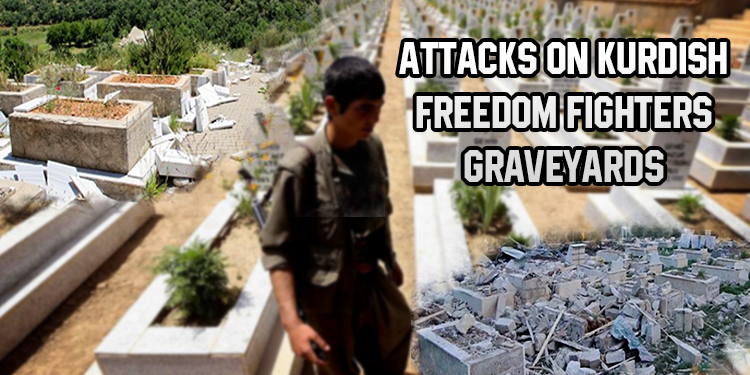NEWS CENTER – “Can a man be killed five times? Hussein Doner, his family suffered a lot when he lost his life in Kobanê. He was killed a second time when Garzan Cemetery was destroyed. When his body was exhumed and abducted, he was killed a third time. “The fourth time he was killed when he was buried on the side of the road in Kilios, and the fifth time he was killed when he was taken to Hizan and buried there.”
This statement was made by Hussein Doner Gulperi Doner. The report of the Mesopotamian Observatory of Justice, published by Dr. Prepared by Dennis Arbet Nejbîr. Hussein Doner lost his life in the 2014 war against ISIS.
ATTACKS STARTED IN 2015
Garzan Cemetery is in the village of Oleka Jor. More than 270 bodies were exhumed at the cemetery in December 2017 without any information being given to their families and then buried in plastic boxes on the side of the road in Kilios, which is about 1,500 kilometers away.
Dr. Speaking to ANF, Nejbir said that the attack on the cemetery was a state concept, adding, “In 2015, with the curfew, the Turkish state started a war against cemeteries. When people started a war of genocide. of the Turkish state, sees that this situation is very different from what it is now. In the 1990s there was an attack on the corpses, but the attack on the cemetery was never carried out. “Erdogan’s regime is committing war crimes against humanity.”
OVER 1600 TOMBS DESTROYED IN 122 ATTACKS
“One of the methods of modern repression is to strengthen the Turkish state’s policy of annihilation against the Kurds,” the report said, referring to the Turkish state’s war against Kurdish graves and cemeteries in 11 cities.
The report said the number of graves damaged or damaged was not immediately clear, adding, “According to the information received, the attacks were carried out in an orderly manner.”
According to the report, Turkish forces attacked Kurdish graves 122 times between 17 September 2015 and 4 April 2020, and provided the following information:
“As a result of this ongoing war against graves and cemeteries, at least 1,644 graves were completely destroyed and 2,926 graves were damaged.”
18 CEMETERIES WERE COMPLETELY DESTROYED
The report said that in the same process, 18 cemeteries in 11 cities in North Kurdistan, including PKK graves, were completely destroyed by airstrikes or explosions.
Dr. Nejbîr said, “The Kurds were collectively punished in 2015-2016 during the curfew, the Kurds were collectively punished. The war that took place in the villages in the 1990s has now spread to the cities and caused great damage.”

CITY TO CITY TOMBS WERE DESTROYED
The report referred to the ongoing war on the graves and shared information about the cities:
– 900 graves were completely destroyed and 1,475 graves were damaged in ,Şrnak,
– 143 graves were completely destroyed and 340 graves were damaged in Diyarbak ,r.
– 200 graves were completely destroyed in hêilh, 369 graves were damaged,
– 150 graves were completely destroyed in Dersim, 3 graves were damaged,
– 41 graves were completely destroyed in Van, 69 graves were damaged,
– 200 graves were destroyed in Siirt,
– 232 graves were destroyed in Mardin,
– 9 graves were completely destroyed, 3 graves were damaged in Pirsus / Riha,
– 267 graves were completely destroyed in Bitlis,
– 54 graves were completely destroyed in Hakkari,
– 27 graves were completely destroyed in Mus, 8 graves were damaged,
– 80 graves were destroyed in Bingewl.
It was also reported that the number of damaged graves in some cemeteries in Airîr,, Mardin and Kars was not clarified. That being said, the balance of the war against these cemeteries may be even heavier.
WHAT IS THE MEANING IN THOSE ATTACKS?
There was no international outcry against these attacks. The destruction of graves and cemeteries is defined in the dictionary as damage to the sanctuary. Some sociologists define it as an attack on the individual, while others define it as a hate crime. In September 2015, when a Baha’i cemetery was destroyed in the Iranian city of Shiraz, the UN Special Rapporteur on Freedom of Religion, Heiner Bielefeldt, protested, saying, “Attacks on cemeteries are unacceptable and a deliberate violation of freedom of expression.” it’s a religion or a belief. ”
In the Encyclopaedic Dictionary of World War II, French anthropologist Nahoum Grappe describes desecration: there is holiness. ”
THEY WANT TO DESTROY THE MEMORY OF RESISTANCE
“With this crime, the Turkish state wants to eradicate the PKK’s resistance against the Turkish state’s policy against the Kurds, thus preventing this collective resistance from turning into a memory,” the report said.
Dr. Nejbîr said, “The main purpose of the attack on the cemeteries is an attempt to destroy the memory of the Kurdish resistance” and added that they had prepared this report for archiving and recording the war crimes of the Turkish state. Dr. Nejbîr stated that if a lawsuit is filed against Turkey in international courts, these data will become evidence. But that is not the only goal. Nejbir said, “We have submitted this report to the United Nations to get involved. We are also sending this report to the relevant rapporteurs.”
Nejbir recently reported that attacks on cemeteries have put them on the agenda of the European Court of Human Rights and that around 40-45 cases have been opened in Turkey.




